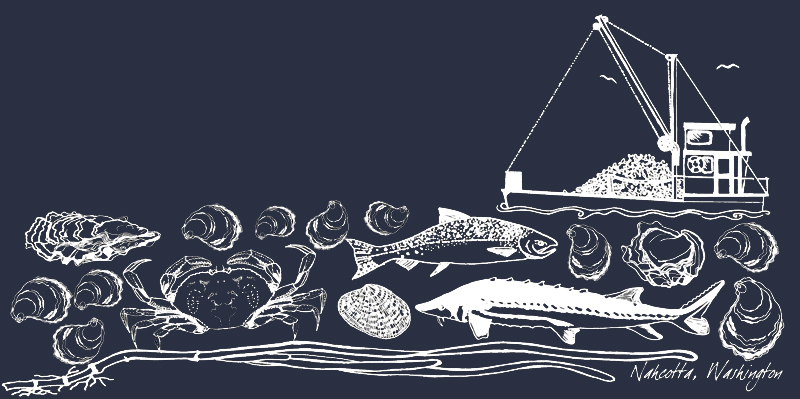
The Shellfish Industry

The Shellfish Industry |
 |
|
What’s the difference between a clam and an oyster?Clams and oysters are both bivalve molluscs. “Bivalve” means “two-shelled”. Clams have two shells that are mirror images of each other. They live buried in sediment and stick out their necks (actually, their siphons, which carry water in and out of the animal) to feed. Oysters, in contrast, have two shells that are slightly different: one is cupped, and the other is flat. Oysters live above the sediment and often attach to one another because each new generation cements itself to existing shells. Oysters have no need of siphons, and they filter water across their gill simply by opening their shell slightly.Clams and oysters both have a 2-stage life cycle. As adults, they pretty much stay put. (Clams are slightly more mobile and can sometimes be seen inching their way across a tideflat.) Obviously, if you can’t move very much, it’s hard to find a partner for reproduction. Clams and oysters avoid this problem by simply releasing their gametes in a population-wide spawning event. In fact, in past times, oysters in the bay were tricked into spawning by tossing ground-up oysters into the bay, because eggs and sperm leaked out and triggered reproduction in others. Eggs are fertilized by sperm in the water, and larvae begin to develop. Larvae spend several weeks floating around, eating phytoplankton and growing, until they are large enough to metamorphose (300 microns, or about 1/100 inch). Then they select a likely spot – clams seem to prefer a muddy beach with round pebbles in the middle of the tideflat, and oysters prefer other oyster shells slightly lower – and reorganize themselves to become miniature versions of adults.Both oysters and clams are farmed in Willapa Bay. The major aquaculture species, Pacific oysters and Manila clams (steamers), are both originally from Asia. Pacific oysters were deliberately introduced to revive a faltering industry (1928 in Willapa Bay), and clams entered as hitchhikers on oysters but were later recognized as a valuable species to farm. Around Nahcotta, you can see piles of oyster shell, crushed oyster shell, and gravel. The whole shell is used to farm oysters, whereas gravel and crushed shell are spread on tideflats to improve conditions for clams.How are oysters produced?Here are the basic steps for oyster farming in Willapa Bay:
The advent of hatcheries has also enabled the production of single oysters, which cater to the live market. To produce a single oyster, shell is ground to a fine powder, with the pieces just big enough for a single oyster to settle. Apparently, oysters prefer not to settle on such small pieces, if other options (such as the sides of tanks) are available, but water flow can be used to push larvae onto the shell grains. Single oysters are then grown in tanks until they reach thumbnail size, again using water flow to prevent them from cementing to each other. Small oysters are carefully planted onto tideflats. In years past, shellstrings were used as a settlement device. Kids could make a little spending money by punching holes through shells and stringing them on a wire 4-6’ long. Bent in half, these wires were draped over scaffolding on the tideflat. Shellstrings were effective but inefficient and now are only used for research purposes. A weekly record of recruitment measured by the Washington Department of Fish and Wildlife and continued by AT stretches back over 50 years. Today, it may seem that finding larvae is an easy step in oyster farming. Natural settlement has become increasingly reliable, and several hatcheries in the region produce billions of larvae annually. For transport, larvae are strained out of the water into a ball about the size of a grapefruit, then placed in damp paper towels in a cooler. At the other end, simply dump them into a tank with shell. In the past, however, larvae were somewhat unpredictable. In fact, from the 1920s until the 1970s, small oysters were imported annually from Japan (with a hiatus during WWII for obvious reasons). These oysters (and anything hitching along) were planted on tideflats to grow into market-sized oysters. In the 1970s, hatchery technology finally overcame the need for continued imports. Three other techniques for growing oysters are carried out in Willapa Bay. (1) Hummocks occur primarily in the south part of the bay where Pacific oysters settle naturally. As oysters settle on each other, they build up reefs on the tideflat that range in size from less than a meter across (1 ft) to 10 m (30 ft). For several years, we believed that hummocks were “wild”, occurring without any human intervention. However, hummocks actually are part of an important technique for raising oysters. Many growers place shell in piles in the south part of the bay, and these piles become hummocks over several years. At this point, the live oysters are removed by hand, usually leaving a shell base that will develop into another hummock. (2) Longlines are used to grow oysters off the bottom, and they have been undertaken in some areas to reduce impacts on eelgrass. PVC poles are placed in the sediment at intervals of ~2 m (6 ft), so they stick up about 0.6 m (2 ft). Two-strand rope is strung across the poles, with cultch inserted between the strands of the rope. As the oysters on these cultch grow, they create small oyster balls on the line. After a few years, the oysters are picked by hand: the line is cut into short pieces with oyster balls, and these are placed in baskets and then tubs for transport to a shucking house. (3) Stake culture (visible on the south side of the Interpretive Center) is just like it sounds: Oysters settle on PVC stakes and grow over several years to harvestable size. Usually, barnacles or oysters that have already settled on stakes encourage the settlement of additional oysters; clean stakes do not work as well.Why are oysters only eaten in months with “R”?The descriptors of a good oyster include terms like “plump, firm and sweet.” Traditionally, oysters were most delectable in fall to spring (September to April). During the summer, oysters become reproductive, triggered by warm water temperatures and enough food in the water. Gonad is soft, so oysters lose their “firm” mouthfeel. Oysters use tremendous amounts of resources to spawn (release eggs and sperm), and their body size can fall by as much as 50% (although the shell remains the same size). Spawned oysters are not “plump.” So, eating oysters in months with “R” has nothing to do with health concerns, only the quality of the dining experience.Oyster growers have recently overcome seasonal variation in oyster quality, which was hard for business. Triploid oysters, which are readily produced in hatcheries, rarely become reproductive. Triploid oysters have 3 copies of each chromosome, in contrast to diploid oysters that contain 2 of each. Because triploids do not develop gonad or spawn, their quality remains high throughout summer months.How many species of oyster live in Willapa Bay?Six!
Oystering termsBasket: Bushel basket something like a sturdy laundry basket, usually orange, used for hand picking oysters. One person can lift a full basket.Bed: Discrete area of tideflat managed in a homogeneous way, for instance, planted or harvested at the same time. The dimensions of the bed are marked with alder stakes that stick up above the water even on high tides. Beds range in size from 1-10 acres. They have a bewildering array of names, including official (A6, E59, C105) and unofficial names (often named for the person who once owned it). The official and unofficial beds usually do not overlap exactly!Cultch: Old shell, no longer alive, used to attract oyster larvae to settle.Cultch bag: Plastic mesh bag filled with cultch. The mesh bags are an easy way to move cultch to the right place and time for larval settlement.Dips: Diploid oysters with 2 copies of each chromosome in their genetic makeup. Diploid oysters can reproduce.Dredge: Boat that drags a metal mesh box across the ground at high tide. Oysters are caught by the mesh, raised, and released onto the flat deck of the dredge. Dredge operators are so skilled that they can collect most of the oysters from a bed even though they cannot see them, only the stakes that mark the bed boundaries. However, we have heard estimates that it takes multiple passes to get all the oysters.Hardening: Placing newly-settled oysters at mid-intertidal elevations so that they grow strong shells over winter.Hummock: Oysters that grow in a dense aggregation, cemented to each other, surrounded by mudflat.Larva: Initial phase of the life cycle of oysters, clams, and many marine invertebrates, usually microscopic and floating in the water. Singular = larva; plural = larvae.Longline: A form of oyster aquaculture in which oysters are attached to ropes held above the sediment on poles. Longlines are also used in fishing and can consist of 100s of meters of baited hooks.Scow: Floating platform that has no motor of its own. Scows are piled with oysters, shell, or gravel and towed around the bay.Seed: Young oysters, ready to be planted.Shell (or cultch) pile: After oysters are shucked, their shells are stored in large piles on land for several weeks to months. This drying process kills any attached organisms, reducing the risk of transporting unwanted species to new areas. The shell is then used as a settlement substrate for a new generation of oysters.Shellstring: Historic method of gathering natural settlement of oysters from the bay. Old shells were spiked to create a hole in the middle, then strung on long wires. These wires were draped over scaffolding in the bay close to the time of oyster settlement. This technique was replaced by cultch bags, which are less labor-intensive.Shuck: Remove the meat of the oyster from the shell. The best shuckers proceed at astonishing paces of a dozen per minute.Spat: Newly-settled oysters.Spatfall: Settlement, usually in June for native oysters and in August for Pacific oysters in Willapa Bay.Spawn: Reproduce by releasing gametes (eggs and sperm) into the water.Trips: Triploid oysters with three copies of each chromosome in their genetic makeup. Triploid oysters only occur in laboratories and hatcheries, not in the wild, and they are unlikely to reproduce.Tub: Large round basket made of metal strips, used in hand-picking oysters. Oyster growers use dredges to move tubs to beds where picking will occur. Floats on the tubs allow them to be retrieved by dredge later. |
UW Biology | University of Washington |
Created by Lee McCoy, Updated by Jerome Tichenor, March 19, 2013 |